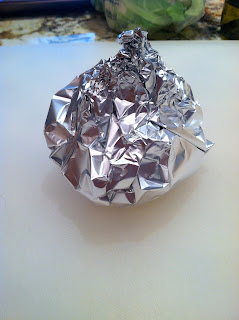Roasting garlic is a wonderful way of slow cooking garlic to mellow the sharp bite that raw garlic has, but enhance the actual garlic flavor. And it makes your house smell amazing and savory. Roasted garlic is great for mashed potatoes, creamy soups and sauces, dips, or spread straight onto crackers or bread. But I have to warn you. About the potential biohazard that can come from consuming too much roasted garlic.
One year I was hosting Thanksgiving. And I made a head of roasted garlic as part of the appetizer spread. There was one family member who dug right into that head of garlic, consuming almost the entire thing in that one day. Now, I was not a witness to the aftermath that night or the next day. But there are stories from others who shared a hotel room with this person and subsequently shared a 5-hour car ride home. So, the moral of the story is don't eat a whole head of roasted garlic in 24 hours or if you do, please make sure there is enough ventilation to save those around you.
Now that I've sufficiently grossed you out (and believe me when I say I really try to keep that at a minimum. Some of my closest friends expect otherwise), let's talk about how to roast garlic. It's not a recipe exactly, but more of a technique. And when I roast garlic, I like to do about 4 heads of garlic at a time, because hey, if I have all the stuff to do it, then why not? Plus, did I mention this stuff is amazing in mashed potatoes??
Step one:
Preheat oven to 400˚ F.
Step two:
Remove the outer papery layers of your head of garlic.
Step three:
Place on a 12x12 piece of foil (Size is approximate. You want your foil big enough to form a pouch around.)
Step four:
Drizzle garlic with 1 Tbsp olive oil.
Step five:
Gather the corners of your foil at the top of the garlic head to create a pouch. Close in sides. It should kinda look like a head of foil garlic, only without the clove definition.
Step six:
Place on a baking sheet and bake for 40 minutes.
Step seven:
Allow to cool completely and then peel each clove. This may seem time consuming and your fingers with get covered in oil and the skins will stick a little bit to your fingers. But it's nothing that a little soap and warm water can't fix when you're done.
Step eight:
Use in mashed potatoes, sauces, soups, dips, or serve as an appetizer.
One year I was hosting Thanksgiving. And I made a head of roasted garlic as part of the appetizer spread. There was one family member who dug right into that head of garlic, consuming almost the entire thing in that one day. Now, I was not a witness to the aftermath that night or the next day. But there are stories from others who shared a hotel room with this person and subsequently shared a 5-hour car ride home. So, the moral of the story is don't eat a whole head of roasted garlic in 24 hours or if you do, please make sure there is enough ventilation to save those around you.
Now that I've sufficiently grossed you out (and believe me when I say I really try to keep that at a minimum. Some of my closest friends expect otherwise), let's talk about how to roast garlic. It's not a recipe exactly, but more of a technique. And when I roast garlic, I like to do about 4 heads of garlic at a time, because hey, if I have all the stuff to do it, then why not? Plus, did I mention this stuff is amazing in mashed potatoes??
Step one:
Preheat oven to 400˚ F.
Step two:
Remove the outer papery layers of your head of garlic.
Step three:
Place on a 12x12 piece of foil (Size is approximate. You want your foil big enough to form a pouch around.)
Step four:
Drizzle garlic with 1 Tbsp olive oil.
Step five:
Gather the corners of your foil at the top of the garlic head to create a pouch. Close in sides. It should kinda look like a head of foil garlic, only without the clove definition.
Step six:
Place on a baking sheet and bake for 40 minutes.
Step seven:
Allow to cool completely and then peel each clove. This may seem time consuming and your fingers with get covered in oil and the skins will stick a little bit to your fingers. But it's nothing that a little soap and warm water can't fix when you're done.
Step eight:
Use in mashed potatoes, sauces, soups, dips, or serve as an appetizer.




Comments
Post a Comment